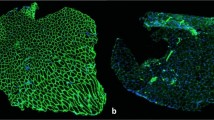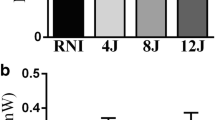Abstract
This study was designed to determine if the levels of oxidative stress markers are influenced by low-level laser therapy (LLLT) in mdx mice subjected to high-intensity exercise training on an electric treadmill. We used 21 C57BL/10ScSn-Dmdmdx/J mice and 7 C57BL/10ScSn mice, all aged 4 weeks. The mice were divided into four groups: a positive control group of normal, wild-type mice (WT); a negative control group of untreated mdx mice; a group of mdx mice that underwent forced high-intensity exercise on a treadmill (mdx fatigue); and another group of mdx mice with the same characteristics that were treated with LLLT at a single point on the gastrocnemius muscle of the hind paw and underwent forced high-intensity exercise on a treadmill. The mdx mice treated with LLLT showed significantly lower levels of creatine kinase (CK) and oxidative stress than mdx mice that underwent forced high-intensity exercise on a treadmill. The activities of the antioxidant enzyme superoxide dismutase (SOD) were higher in control mdx mice than in WT mice. LLLT also significantly reduced the level of this marker. LLLT had a beneficial effect also on the skeletal muscle performance of mdx mice. However, the single application of LLLT and the dose parameters used in this study were not able to change the morphology of a dystrophic muscle.







Similar content being viewed by others
References
Turk R, Sterrenburg E, de Meijer EJ, van Ommen GJ, den Dunnen JT, Hoen PA (2005) Muscle regeneration in dystrophin-deficient mdx mice studied by gene expression profiling. BMC Genomics 6:98
Petrof BJ (2002) Molecular pathophysiology of myofiber injury in deficiencies of the dystrophin-glycoprotein complex. Am J Phys Med Rehabil 81(11 Suppl):S162–S174
Yin HF, Moulton HM, Betts C, Merritt T, Seow Y, Ashraf S, Wang QS, Boutilier J, Wood MJA (2010) Functional rescue of dystrophin-deficient mdx mice by a chimeric peptide-PMO. Mol Ther 18(10):1822–1829
Andersson DC, Meli AC, Reiken S, Betzenhauser MJ, Umanskaya A, Shiomi T, D’Armiento J, Marks AR (2012) Leaky ryanodine receptors in β-sarcoglycan deficient mice: a potential common defect in muscular dystrophy. Skelet Muscle 2(1):9
Kaczor JJ, Hall JE, Payne E, Tarnopolsky MA (2007) Low intensity training decreases markers of oxidative stress in skeletal muscle of mdx mice. Free Radic Biol Med 43(1):145–154
Meadows E, Flynn JM, Klein WH (2011) Myogenin regulates exercise capacity but is dispensable for skeletal muscle regeneration in adult mdx mice. PLoS One 6(1):e16184
Terrill JR, Radley-Crabb HG, Iwasaki T, Lemckert FA, Arthur PG, Grounds MD (2013) Oxidative stress and pathology in muscular dystrophies: focus on protein thiol oxidation and dysferlinopathies. FEBS J 280(17):4149–4164
Angelini C, Tasca E (2012) Fatigue in muscular dystrophies. Neuromuscul Disord 22(Suppl 3):S214–S220
Koyama H, Nojiri H, Kawakami S, Sunagawa T, Shirasawa T, Shimizu T (2013) Antioxidants improve the phenotypes of dilated cardiomyopathy and muscle fatigue in mitochondrial superoxide dismutase-deficient mice. Molecules 18(2):1383–1393
De Marchi T, Leal Junior EC, Bortoli C, Tomazoni SS, Lopes-Martins RA, Salvador M (2012) Low-level laser therapy (LLLT) in human progressive-intensity running: effects on exercise performance, skeletal muscle status, and oxidative stress. Lasers Med Sci 27(1):231–236
Leal-Junior EC, Johnson DS, Saltmarche A, Demchak T (2014) Adjunctive use of combination of super-pulsed laser and light-emitting diodes phototherapy on nonspecific knee pain: double-blinded randomized placebo-controlled trial. Lasers Med Sci 29(6):1839–1847
Firat ET, Dağ A, Günay A, Kaya B, Karadede MI, Ersöz Kanay B, Ketani A, Evliyaoğlu O, Uysal E (2013) The effect of low-level laser therapy on the healing of hard palate mucosa and the oxidative stress status of rats. J Oral Pathol Med
Dawood MS, Salman SD (2013) Low level diode laser accelerates wound healing. Lasers Med Sci 28(3):941–945
Alves AC, Albertini R, Dos Santos SA, Leal-Junior EC, Santana E, Serra AJ, Silva JA Jr, de Carvalho PD (2014) Effect of low-level laser therapy on metalloproteinase MMP-2 and MMP-9 production and percentage of collagen types I and III in a papain cartilage injury model. Lasers Med Sci 29(3):911–919
Alves AC, Vieira RD, Leal-Junior EC, Dos Santos SA, Ligeiro AP, Albertini R, Junior JA, de Carvalho PD (2013) Effect of low-level laser therapy on the expression of inflammatory mediators and on neutrophils and macrophages in acute joint inflammation. Arthritis Res Ther 15(5):R116
de Almeida P, Tomazoni SS, Frigo L, de Carvalho PT, Vanin AA, Santos LA, Albuquerque-Pontes GM, De Marchi T, Tairova O, Marcos RL, Lopes-Martins RÁ, Leal-Junior EC (2014) What is the best treatment to decrease pro-inflammatory cytokine release in acute skeletal muscle injury induced by trauma in rats: low-level laser therapy, diclofenac, or cryotherapy? Lasers Med Sci 29(2):653–658
Sussai DA, Carvalho Pde T, Dourado DM, Belchior AC, dos Reis FA, Pereira DM (2010) Low-level laser therapy attenuates creatine kinase levels and apoptosis during forced swimming in rats. Lasers Med Sci 25(1):115–120
Leal Junior EC, Lopes-Martins RA, de Almeida P, Ramos L, Iversen VV, Bjordal JM (2010) Effect of low-level laser therapy (GaAs 904 nm) in skeletal muscle fatigue and biochemical markers of muscle damage in rats. Eur J Appl Physiol 108(6):1083–1088
de Almeida P, Lopes-Martins RÁ, Tomazoni SS, Silva JA Jr, de Carvalho PT, Bjordal JM, Leal Junior EC (2011) Low-level laser therapy improves skeletal muscleperformance, decreases skeletal muscle damage and modulates mRNA expression of COX-1 and COX-2 in a dose-dependent manner. Photochem Photobiol 87(5):1159–1163
Leal Junior EC, Lopes-Martins RA, Rossi RP, De Marchi T, Baroni BM, de Godoi V, Marcos RL, Ramos L, Bjordal JM (2009) Effect of cluster multi-diode light emitting diode therapy (LEDT) on exercise-induced skeletal muscle fatigue and skeletal muscle recovery in humans. Lasers Surg Med 41(8):572–577
de Almeida P, Lopes-Martins RA, De Marchi T, Tomazoni SS, Albertini R, Corrêa JC, Rossi RP, Machado GP, da Silva DP, Bjordal JM, Leal Junior EC (2012) Red (660 nm) and infrared (830 nm) low-level laser therapy in skeletal muscle fatigue in humans: what is better? Lasers Med Sci 27(2):453–458
Blake DJ, Weir A, Newey SE, Davies KE (2002) Function and genetics of dystrophin and dystrophin-related proteins in muscle. Physiol Rev 82(2):291–329
Charge SB, Rudnicki MA (2004) Cellular and molecular regulation of muscle regeneration. Physiol Rev 84(1):209–238
Liu XG, Zhou YJ, Liu TC, Yuan JQ (2009) Effects of low-level laser irradiation on rat skeletal muscle injury after eccentric exercise. Photomed Laser Surg 27(6):863–869
Cozzoli A, Nico B, Sblendorio VT, Capogrosso RF, Dinardo MM, Longo V, Gagliardi S, Montagnani M, De Luca A (2011) Enalapril treatment discloses an early role of angiotensin II in inflammation- and oxidative stress-related muscle damage in dystrophic mdx mice. Pharmacol Res 64(5):482–492
Ragusa RJ, Chow CK, Porter JD (1997) Oxidative stress as a potential pathogenic mechanism in an animal model of Duchenne muscular dystrophy. Neuromuscul Disord 7:379–386
Disatnik MH, Dhawan J, Yu Y, Beal MF, Whirl MM, Franco AA, Rando TA (1998) Evidence of oxidative stress in mdx mouse muscle: studies of the pre-necrotic state. J Neurol Sci 161:77–84
Nakano J, Kataoka H, Sakamoto J, Origuchi T, Okita M, Yoshimura T (2009) Low-level laser irradiation promotes the recovery of atrophied gastrocnemius skeletal muscle in rats. Exp Physiol 94(9):1005–1015
Leal-Junior EC, Vanin AA, Miranda EF, de Carvalho PD, Dal Corso S, Bjordal JM (2015) Effect of phototherapy (low-level laser therapy and light-emitting diode therapy) on exercise performance and markers of exercise recovery: a systematic review with meta-analysis. Lasers Med Sci 30(2):925–939
Leal-Junior EC, de Almeida P, Tomazoni SS, de Carvalho PT, Lopes-Martins RÁ, Frigo L, Joensen J, Johnson MI, Bjordal JM (2014) Superpulsed low-level laser therapy protects skeletal muscle of mdx mice against damage, inflammation and morphological changes delaying dystrophy progression. PLoS One 9(3):e89453
Leal-Junior EC (2015) Photobiomodulation therapy in skeletal muscle: from exercise performance to muscular dystrophies. Photomed Laser Surg 33(2):53–54
Acknowledgments
Professor Paulo de Tarso Camillo de Carvalho would like to thank the Brazilian Council of Research and Development (CNPq) for the support for this study (process number 472334/2011-5). Professor Ernesto Cesar Pinto Leal-Junior would like to thank the Brazilian Council of Research and Development (CNPq) for the support for this study (process number 307717/2014-3).
Conflict of interest
Professor Ernesto Cesar Pinto Leal-Junior receives research support from Multi Radiance Medical (Solon, OH, USA), a laser device manufacturer. The remaining authors declare that they have no conflict of interests.
Author information
Authors and Affiliations
Corresponding author
Rights and permissions
About this article
Cite this article
Silva, A.A.d., Leal-Junior, E.C.P., D’Avila, K.d.L. et al. Pre-exercise low-level laser therapy improves performance and levels of oxidative stress markers in mdx mice subjected to muscle fatigue by high-intensity exercise. Lasers Med Sci 30, 1719–1727 (2015). https://doi.org/10.1007/s10103-015-1777-7
Received:
Accepted:
Published:
Issue Date:
DOI: https://doi.org/10.1007/s10103-015-1777-7




